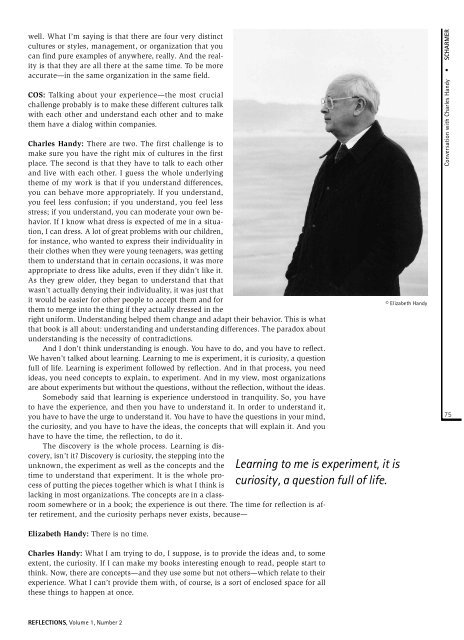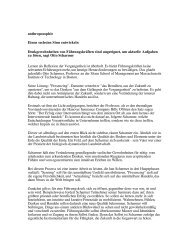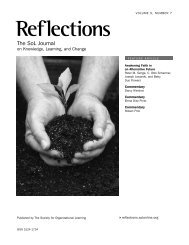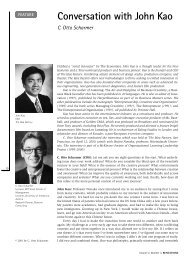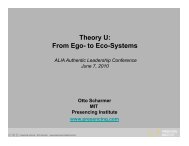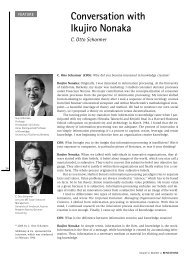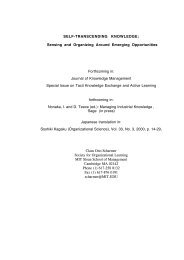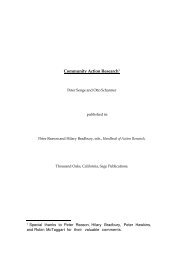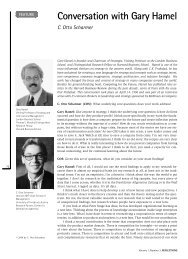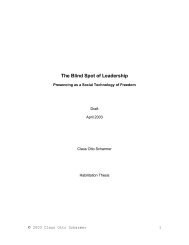<strong>Conversation</strong> <strong>with</strong> <strong>Charles</strong> <strong>Handy</strong> SCHARMERmuch use. There are five elements to federalism and we have talked about two:subsidiarity (responsibility at the lowest point) and the separation of functions at thecenter. But there are three more, of which perhaps the most important is interdependence.The way you hold parts, the individual states, into the whole is not just through a contractualconstitution but because they would not survive very easily outside. Several ofthe functions that they need in order to perform effectively are done by other membersof the federation. We can’t actually take Massachusetts out of the United States, becausethe state needs the corn grown in Kansas or financial operations on Wall Street or whatever.There is an interdependence, and it is very important to structure that in. There is acoordinating device which insures that no one particular business unit could do it all byitself. Of course, there are also inefficiencies in coordinating, but it does mean that it ismore difficult to break away, unless there’s another federation that also has those samecoordinating devices. But not only does that stop breakaways; it also means that you feelthat you have to invest in the total federation, because you get something from it as wellas giving something to it. This is this other idea of twin citizenship. You have this emotionalcommitment to your individual unit, but you also have an emotional commitmentto the whole federation.COS: The last issue that I would like to address involves both the concept of paradox andhow to deal <strong>with</strong> paradoxes and the concepts of the multiple cultures, as you argued forin Gods of Management. You described four different modes of doing things or four differentmodes of cultures, and it is very intriguing to me, seeing how they emerge and reemergein different relationships and different realities. What is the underlying conceptthat makes the integration of these diverse concepts possible?<strong>Charles</strong> <strong>Handy</strong>: While I think they are related, I think there are two different issues. Idon’t think I have dealt <strong>with</strong> the question of paradox as well as I would like. What I amtrying to say is that there is almost a necessity of contradictions in life. In order to haveblack, you have to have white. Otherwise, it doesn’t seem like black.COS: And otherwise you don’t get color.74<strong>Charles</strong> <strong>Handy</strong>: You don’t get color. Leisure has no meaning unless there is also work oreffort. Valleys don’t exist unless there are hills. There is a logical necessity for oppositesor contradictions in life. And that applies throughout. We are used to it in the examples Ihave just given. We have learned to live <strong>with</strong> black and white, even if we don’t like black.But we don’t seem to have learned to live <strong>with</strong> that in the rest of the world. I’m trying tosay that in organizations, it is both-and, not either-or.We have created an ideal form or organization whereby we say we can have, forinstance, total control in the center, and you can be an individual. People say, “Well,that’s not possible. If you control, obviously you don’t trust me.” I’m saying, obviouslyyou can, but you have got to live <strong>with</strong> the seesaw. You have got to live <strong>with</strong> the fact thatone time you need control and sacrifice your freedom, and another time you need thefreedom and sacrifice some control. Life is always like that. I think we have got to trainpeople to live <strong>with</strong> what looks like confusion but is actually the necessity to alternatebetween valleys and hills all the time. You really can’t have both at the same time, butyou can have both in the same field.COS: I see.<strong>Charles</strong> <strong>Handy</strong>: I don’t think I explained it very well in the book, but it seems to be veryimportant: that you can have a very strong leader and very strong individuals. You probablyhave the two, not at the same time, but in the same place or the same field. But atthe same time, they fight against each other. So, sometimes the leadership has to actuallylet the individuals be strong. To some extent, that applies in the same way to theGods of Management, which I think is one of my most neglected books in America. I amvery fond of that book. It has the seeds of all of my other books in it, really. I am fond ofit because I think it helps people to understand the confusions of organizations quiteVolume 1, Number 2, REFLECTIONS
well. What I’m saying is that there are four very distinctcultures or styles, management, or organization that youcan find pure examples of anywhere, really. And the realityis that they are all there at the same time. To be moreaccurate—in the same organization in the same field.COS: Talking about your experience—the most crucialchallenge probably is to make these different cultures talk<strong>with</strong> each other and understand each other and to makethem have a dialog <strong>with</strong>in companies.<strong>Charles</strong> <strong>Handy</strong>: There are two. The first challenge is tomake sure you have the right mix of cultures in the firstplace. The second is that they have to talk to each otherand live <strong>with</strong> each other. I guess the whole underlyingtheme of my work is that if you understand differences,you can behave more appropriately. If you understand,you feel less confusion; if you understand, you feel lessstress; if you understand, you can moderate your own behavior.If I know what dress is expected of me in a situation,I can dress. A lot of great problems <strong>with</strong> our children,for instance, who wanted to express their individuality intheir clothes when they were young teenagers, was gettingthem to understand that in certain occasions, it was moreappropriate to dress like adults, even if they didn’t like it.As they grew older, they began to understand that thatwasn’t actually denying their individuality, it was just thatit would be easier for other people to accept them and forthem to merge into the thing if they actually dressed in theright uniform. Understanding helped them change and adapt their behavior. This is whatthat book is all about: understanding and understanding differences. The paradox aboutunderstanding is the necessity of contradictions.And I don’t think understanding is enough. You have to do, and you have to reflect.We haven’t talked about learning. Learning to me is experiment, it is curiosity, a questionfull of life. Learning is experiment followed by reflection. And in that process, you needideas, you need concepts to explain, to experiment. And in my view, most organizationsare about experiments but <strong>with</strong>out the questions, <strong>with</strong>out the reflection, <strong>with</strong>out the ideas.Somebody said that learning is experience understood in tranquility. So, you haveto have the experience, and then you have to understand it. In order to understand it,you have to have the urge to understand it. You have to have the questions in your mind,the curiosity, and you have to have the ideas, the concepts that will explain it. And youhave to have the time, the reflection, to do it.The discovery is the whole process. Learning is discovery,isn’t it? Discovery is curiosity, the stepping into theLearning to me is experiment, it iscuriosity, a question full of life.unknown, the experiment as well as the concepts and thetime to understand that experiment. It is the whole processof putting the pieces together which is what I think islacking in most organizations. The concepts are in a classroomsomewhere or in a book; the experience is out there. The time for reflection is afterretirement, and the curiosity perhaps never exists, because—© Elizabeth <strong>Handy</strong><strong>Conversation</strong> <strong>with</strong> <strong>Charles</strong> <strong>Handy</strong> SCHARMER75Elizabeth <strong>Handy</strong>: There is no time.<strong>Charles</strong> <strong>Handy</strong>: What I am trying to do, I suppose, is to provide the ideas and, to someextent, the curiosity. If I can make my books interesting enough to read, people start tothink. Now, there are concepts—and they use some but not others—which relate to theirexperience. What I can’t provide them <strong>with</strong>, of course, is a sort of enclosed space for allthese things to happen at once.REFLECTIONS, Volume 1, Number 2


